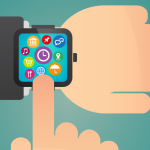“Data-Driven Thinking” is written by members of the media community and contains fresh ideas on the digital revolution in media. The column, written by Pat LaPointe, EVP at Resonate originally appeared in AdExchanger //
The Internet of Things (IoT) – where physical products can connect to the web and communicate with users and other products – has presented brands with new ways to engage consumers along the path to purchase. Marketers, such as Diageo and its “smart bottle,” have already launched products that are used as new communication channels to create ongoing conversations with consumers.
But while exploring the full spectrum of opportunities, brands should tread carefully. The IoT can also bring new types of risks that could significantly outweigh potential benefits and damper enthusiasm for this accelerating phenomenon.
IoT: A Risky Data Business
The real thrill for brands with IoT relates to data and what digital marketers can do with it. Brands will have access to data from 25 billion connected “things” by 2020, according to Gartner, which will help marketers significantly increase message targeting accuracy and effectiveness.
But in an era of rising security hacks and increasingly sophisticated “phishing” scams, the IoT opens up new nodes through which malfeasance can bring highly destructive and costly results, and even violate consumers’ sense of privacy. Vulnerabilities can run the gamut of refrigerators sending malicious emails to hackers spying into families’ homes through baby monitors.
To mitigate these risks, I see several specific focal points where brands should approach IoT with consumer protection at the core of their operating philosophy.
Opt-In: The Key To Preserving Consumer Control And Trust
Personal data privacy has become a hot button for consumers. Some 92% of US Internet users worry about their online privacy, according to a TRUSTe study, while 89% say they avoid doing business with companies they believe do not protect their privacy online.
To alleviate consumers’ concerns, brands should give consumers every opportunity to control their personal data and the extent to which they receive branded content. This process can start as early as product design. Rather than rely on unique web page interfaces for each and every appliance, for example, kitchen appliance brands, such as Maytag or Electrolux, could incorporate simple LCD screens into smart appliances that show clear messages about privacy settings alongside operating settings.
This would allow consumers to easily opt in to a variety of data settings in the beginning, while also allowing the brand’s marketers to display relevant, contextually branded messages and notifications, such as special offers or alerts on low household supplies. As consumers’ preferences change, they can also easily return to the appliance’s interface and modify IoT-enabled settings.
In the long term, by providing various opportunities for consumers to opt in and out, brands preserve trust and entice consumers to engage with the brand in new ways.
Adopt Minimalist Big Data Policies
Earlier this year, the FTC published an IoT report with recommendations on how businesses can embrace strategic commercial opportunities. One recommendation revolved around the judicious use of data by “limiting the collection of consumer data, and retaining that information only for a set period of time, and not indefinitely.”
The report further noted that data minimization addresses two key privacy risks. There is the risk that a company with a large store of consumer data will become a more enticing target for data thieves or hackers, and second, that consumer data will be used in ways contrary to their expectations.
This idea of data minimization should be a key policy for brands as they embrace the IoT. While big data has become all the rage, small data can also provide marketers with equally useful, actionable information at a fraction of the cost.
Understand Consumers’ Motivations Before Activating IoT
IoT conversations shouldn’t even start until brands have a firm grip of what drives their consumers’ behaviors. Otherwise, brands could be acting on false assumptions about what’s really relevant and invest in the wrong products and marketing strategies.
Clorox, for example, recently revealed how, contrary to prior belief, it learned that its older demographic customers preferred discounts to loyalty programs. This insight helped Clorox develop initiatives that drove more valuable onsite engagement, such as offering a coupon in exchange for a product review.
IoT discussions can benefit greatly by first ensuring a deep understanding of why consumers feel loyal to one brand over another, why they decide to purchase the things they do or don’t, and how marketers can relevantly reach them in a way that adds value but doesn’t intrude into their daily lives.
As IoT and connected products hit their stride in the marketplace, smart data practices will make the difference between success and failure for brand marketers.
Categorized as: Blog Page, News & Press

